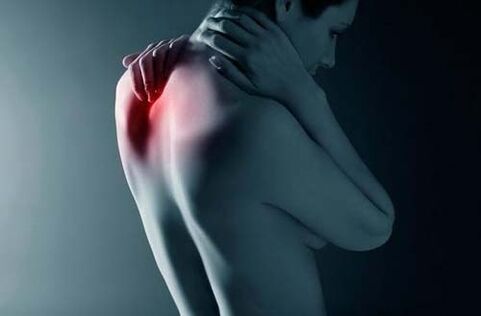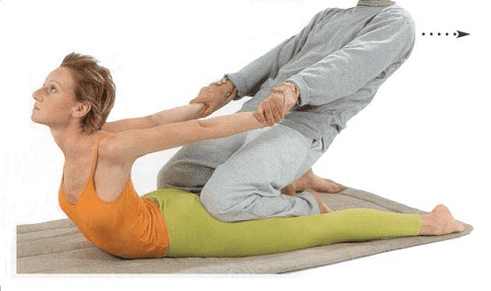By osteochondrosis of the thoracic spine, doctors mean the corresponding degenerative-dystrophic process in this area, which results in pathological deformation of cartilage and bone, destruction of ligaments, joints and intervertebral discs.
Because of appearance

The thoracic bone is less mobile than the cervical and lumbar spine, therefore the pathological process in this area is less obvious, mainly due to the strong design of the joints of the ribs, sternum and vertebrae.However, it occurs no less often than other types of osteochondrosis.Most people who are always in a sitting position at home or at work are prone to weakness of the spinal muscles, scoliosis, injuries to this area, poor posture and, as a result, thoracic osteochondrosis.
As mentioned above, the main cause of this disease is considered to be a pathological deformation in the intervertebral disc and structural joints.The cartilaginous surface is destroyed, the disc becomes thinner, osteophytes, protrusions, hernias form, the nucleus pulposus is reduced and finally the radicular structure of the spinal nerve is damaged, compressive myelopathy and vascular myeloschaemia occur.
The first symptoms and signs of thoracic osteochondrosis
Signs of osteochondrosis are not as pronounced as in this type of disease, and unqualified doctors periodically confuse them with symptoms of other diseases.The above problems lead to the development of pain in the thoracic and interscapular region, which is very intensive with movement and physical work.Pinched nerve fibers trigger unpleasant conductive sensations in the heart and even the liver, and also form pathologies in the functioning of several other organs.
There are two types of pain associated with osteochondrosis of the thoracic region.
- Dorsalgia is a moderate pain syndrome in the affected area, accompanied by unpleasant sensations.
- Dorsago - severe paroxysmal pain, intense and, as a rule, short-term.In this case, the patient may have difficulty breathing and motor abilities in the affected area.
Common symptoms
- Painful sensation in the interscapular region.They are accompanied by "shooting" of the intercostal nerve in the affected area and the corresponding neuralgia.
- Pain syndrome on the left side of the chest, similar to ischemia.
- Girdle pain in the chest, increases significantly with high physical activity.
- Limited thoracic activity/mobility.These symptoms, characteristic of osteochondrosis of the thoracic region, are often confused with the manifestation of scoliotic deformity, as well as ankylosing spondylitis/forestier/scheerman-mao disease.
- "Turns on" pain in the gastrointestinal tract, heart and liver.
- Sexual dysfunction.
- Partial chest numbness.
Treatment of osteochondrosis of the thoracic region
Osteochondrosis of the thoracic spine is treated exclusively with complex long-term therapy, including a set of exercises, various physical and manual procedures, as well as medications.
How to treat?

The treatment process consists of several stages.The first is the elimination of pain symptoms.Along with this, restorative and preventive therapy is used, including several techniques and approaches - from acupuncture to physical therapy.The final stage is maintenance therapy.The duration of treatment for this disease varies and depends on the medical technique used and on the current condition of the patient, as well as the degree of osteochondrosis itself.
Popular medicine for thoracic osteochondrosis
- Painkillers.NSAIDs and analgesics based on various combinations.
- Hydroprotectors.It is necessary to catalyze the process of restoration of damaged cartilage.
- Vitamins.Often, vitamin complexes or complete preparations with B-group elements are prescribed.
- External means.Cream or ointment based on glucocorticosteroids.In addition, local agents are used to relieve inflammation in the affected area and reduce the symptoms of the disease.
- Injections and injections.Often they are performed in a hospital setting and are complex paravertebral blockades with long-acting anesthetics.In addition, these drugs improve blood circulation and also promote the recovery of cartilage tissue.
Massage
Massage not only reduces the severity of the symptoms of this disease, but also helps a person to recover, resulting in positive effects from other elements of complex therapy.It is prescribed individually based on the clinical picture of osteochondrosis of the thoracic spine, the presence of chronic diseases and contraindications.
Manual therapy relieves pain syndromes of various etiologies, prevents spinal atrophy, normalizes blood circulation and nutrition of the intervertebral discs, relieves static muscles in the affected area, and triggers the natural process of cartilage tissue regeneration.

The main types of massage for osteochondrosis of the thoracic spine:
- Place.
- Medicines.
- Removed hardware.
- Reflex-periosteal.
- Connective tissue.
Gymnastics and exercise therapy
Therapeutic physical exercises and sets of gymnastic exercises are one of the most important stages in the rehabilitation of the spine after osteochondrosis.Naturally, it should be prescribed taking into account the level of the disease and the condition of the patient by a professional doctor alone.
The basic task of exercise therapy/gymnastics is the systematic development of cartilage, as well as strengthening of the spinal muscles.With an appropriate diagnosis, the author's training set is often prescribed: The system includes both general strengthening procedures and methods of direct impact on the most problematic areas, as well as indicator exercises that make it easy to detect the effectiveness of treatment.
In private practice they also use variable sets of exercises using different methods using special devices.Level of treatment in this case:
- Relieves spasms and fighting sensations.
- Therapeutic load on the short back muscles.
- Normalization of circulation in the intervertebral disc.
- Restoration of the basic structure of the spine.
Physiotherapy and alternative therapies

Methods of treating osteochondrosis of the thoracic spine may include hardware and alternative therapies, as well as various physical procedures.The most famous and popular method:
- Electrophoresis.A well-known non-operative method affecting the spine, which has been used since the 70s of the last century.
- Straight stretch.This method is a relatively safe and effective method of straightening the spine, if, of course, it is carried out by a qualified specialist.It is carried out on a massage couch.
- Vacuum therapy.One type of active influence on the affected area uses a vacuum can.
- Acupuncture.Classical acupuncture is performed with a special thin needle that plunges into the depth of the epithelium at the acupuncture point on the back.
- Laser piercing.An activity similar to acupuncture, but performed using a laser beam.
- Magnetopuncture.Impact on problem areas with alternating magnetic fields.
- Osteopathy.A complex method that includes elements of massage, chiropractic and orthopedic techniques.
- Electrical stimulation.Using electric current to normalize spinal function.
- Shock Wave Therapy.This technique is based on the use of infrasound acoustic waves in the treatment of osteochondrosis of the thoracic spine.
- Traction machine decompression.Automatic analogue of direct stretching.
Prevention
The rules to prevent this disease are simple and unambiguous:
- Regular training under orthopedic supervision.
- Normalization of body weight.
- The use of foods and medicines rich in magnesium and calcium.
- Correct posture when working in a sitting position.
- Stop bad habits.
Questions - Answers
What kind of pain occurs with osteochondrosis of the thoracic spine?
With this type of osteochondrosis, patients experience two types of pain syndromes.
- Dorsago is a severe short-term pain with high intensity, which periodically manifests itself against the background of decreased motor activity in the affected area and breathing difficulties.
- Dorsalgia is a long-term background pain of moderate or low intensity that increases with physical activity.
Localization of pain sensations above:
- Interscapular region.
- Girdle chest pain with partial numbness.
- Painful "shooting" in the left upper chest, similar to ischemia.
- Refers to pain in the liver, heart and gastrointestinal tract.
Is gymnastics useful for thoracic osteochondrosis?
Gymnastics and exercise therapy is one of the main elements of complex therapy for this disease.With its help, you can strengthen your back muscles, improve blood microcirculation and develop cartilage/intervertebral discs.Naturally, gymnastics itself, as a separate type of therapy, will not help to get rid of osteochondrosis of the thoracic spine: to consolidate the positive effect, it is necessary to take appropriate medications, as well as regularly attend physical procedures.























